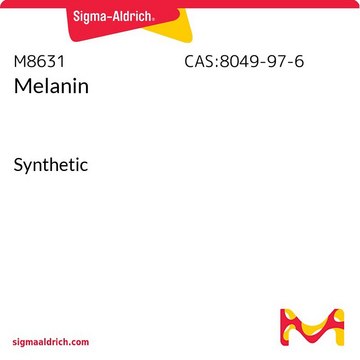93829
L-Tyrosine
≥99.0% (NT), suitable for ligand binding assays, BioUltra
Synonym(s):
(S)-2-Amino-3-(4-hydroxyphenyl)propionic acid, 3-(4-Hydroxyphenyl)-L-alanine
About This Item
Recommended Products
product name
L-Tyrosine, BioUltra, ≥99.0% (NT)
product line
BioUltra
Quality Level
Assay
≥99.0% (NT)
form
powder or crystals
optical activity
[α]20/D −11.5±1.0°, c = 4% in 1 M HCl
technique(s)
ligand binding assay: suitable
impurities
insoluble matter, passes filter test
≤0.5% foreign amino acids
ign. residue
≤0.1%
loss
≤0.2% loss on drying, 20 °C (HV)
color
white
mp
>300 °C (dec.) (lit.)
solubility
1 M HCl: 25 mg/mL, clear, colorless (hot)
anion traces
chloride (Cl-): ≤400 mg/kg
sulfate (SO42-): ≤300 mg/kg
cation traces
Al: ≤5 mg/kg
As: ≤0.1 mg/kg
Ba: ≤5 mg/kg
Bi: ≤5 mg/kg
Ca: ≤10 mg/kg
Cd: ≤5 mg/kg
Co: ≤5 mg/kg
Cr: ≤5 mg/kg
Cu: ≤5 mg/kg
Fe: ≤5 mg/kg
K: ≤50 mg/kg
Li: ≤5 mg/kg
Mg: ≤5 mg/kg
Mn: ≤5 mg/kg
Mo: ≤5 mg/kg
NH4+: ≤200 mg/kg
Na: ≤200 mg/kg
Ni: ≤5 mg/kg
Pb: ≤5 mg/kg
Sr: ≤5 mg/kg
Zn: ≤5 mg/kg
absorption
cut-off at 310 nm in 1 M HCl at 0.5 M
SMILES string
N[C@@H](Cc1ccc(O)cc1)C(O)=O
InChI
1S/C9H11NO3/c10-8(9(12)13)5-6-1-3-7(11)4-2-6/h1-4,8,11H,5,10H2,(H,12,13)/t8-/m0/s1
InChI key
OUYCCCASQSFEME-QMMMGPOBSA-N
Looking for similar products? Visit Product Comparison Guide
Application
Other Notes
Storage Class Code
11 - Combustible Solids
WGK
WGK 1
Flash Point(F)
Not applicable
Flash Point(C)
Not applicable
Personal Protective Equipment
Certificates of Analysis (COA)
Search for Certificates of Analysis (COA) by entering the products Lot/Batch Number. Lot and Batch Numbers can be found on a product’s label following the words ‘Lot’ or ‘Batch’.
Already Own This Product?
Find documentation for the products that you have recently purchased in the Document Library.
Customers Also Viewed
Articles
Inborn errors of metabolism are caused by changes in specific enzymatic reactions and hundreds of different such alterations, which affect about 1 of every 5000 newborns, have been characterized.
Our team of scientists has experience in all areas of research including Life Science, Material Science, Chemical Synthesis, Chromatography, Analytical and many others.
Contact Technical Service








